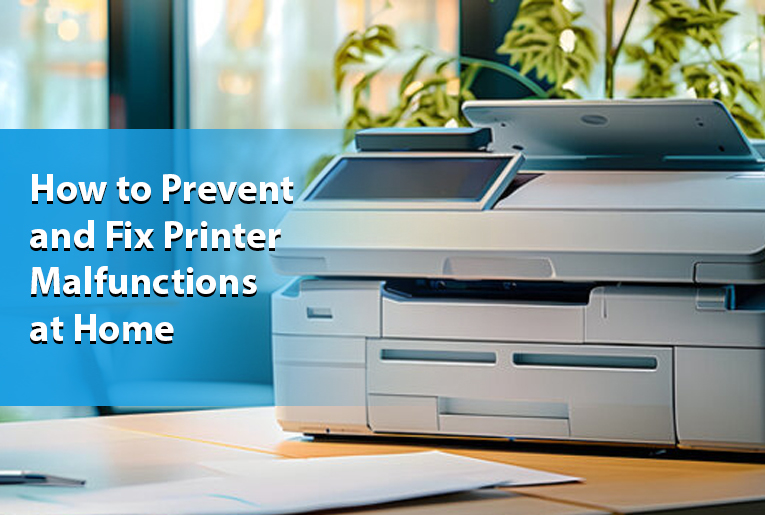Printers are essential for every house office and working space. From printing necessary documents to pictures, they could become unsung heroes in doing everyday tasks. However, when it doesn’t work as usual, the frustration of having to cope with this printer malfunction could be highly challenging, especially if one needs something to be printed within a limited timeframe or urgently. The good news is that you don’t have to panic. With a few simple steps, you can prevent printer malfunctions and fix most issues quickly.
In this guide, we will explore how to keep your printer running smoothly and how to fix printer malfunctions at home.
1. Keep Your Printer Clean
Most printer breakdowns occur because of the dirtiness and dust trapped within the printer. Dust, paper fragments, and ink can build up inside the device, which can lead to frequent jams, poor print quality, and even hardware breakdowns.
Prevention Tip: Always clean the exterior and interior of your printer. For the outside, use a soft, lint-free cloth to clean the surface of your printer. For the inside, lightly vacuum or use compressed air to clean the printer of dust and scraps of paper. Clean your print head and ink cartridges to maintain your quality prints and prevent any malfunctions in your printer in the future.
2. Check for Paper Jams
Paper jamming is among the most common printer problems that can completely bring down your printing process. The paper can get stuck at several places in the printer from the input tray to the output bin, causing frustration and delays.
How to Fix It: Troubleshoot a paper-jammed printer malfunction. This can be caused by paper jamming in a printer. Shut down the printer and then unplug it. From there, you would open the access panels to remove the jammed papers carefully so that no small pieces are left behind. Reboot your printer, and you’re fine. The quality paper must also be used, as well as avoiding overstuffing in the paper tray; otherwise, misfeeding of the paper would occur.
3. Check Proper Connection
A printer breakdown may not always be a mechanical problem. It is most of the time a connection problem. Your printer isn’t working, or errors keep coming up when trying to print, which might indicate a problem in the connectivity between your printer and computer or network.
Prevention Tip: Make sure your printer is properly connected to the computer via USB or wirelessly. The printer and your device for wireless printers should be on the same Wi-Fi network. Wired will check your USB cable to see if there is a tear in it or loose connections.
Fix: If the connection is lost, restart both your printer and computer. Then go into your printer settings and reconnect as prompted.
4. Regularly update your printer drivers.
Outdated drivers are another common cause of printer malfunctions. Printer manufacturers regularly release driver updates to ensure compatibility with newer operating systems and to fix bugs. If you’re experiencing printing errors or slow performance, it might be time to update your drivers.
Prevention Tip: Set a reminder to check for driver updates every few months. Visit the printer manufacturer’s website or use your printer’s companion software to download the latest drivers.
Fix: If you’re already experiencing a printer malfunction due to outdated drivers, simply visit the manufacturer’s site, download the latest version, and install it on your computer. This simple fix can solve many issues related to printing errors and slow performance.
5. Ink and Toner Levels
The other kind of printer error that could occur is when the ink or toner levels are running low. With low levels of ink, you would have faded prints, images of poor quality, or even fail to print altogether.
Prevention Tip: Monitor your printer’s ink and toner regularly. Most printers have an ink level monitoring tool or app that shows you the amount of ink and the toner, or they will let you know through an alert that you are running out of ink to avoid problems like these.
If you suspect that the printer is not working properly due to low ink, replace the ink or toner cartridges. You should use good-quality ink or toner that is intended for your model printer so that it will not underperform.
6. Reset Your Printer
A printer malfunction can often be fixed by a simple reset if everything else fails. When a printer becomes stuck in an error state or won’t respond, it is quickly brought back to work again by a reset that clears any internal errors.
How to Cure It: To reset the printer, turn off the machine, unplug it, and leave it that way for 30 seconds. Then, plug it back in. Turn on the printer and check to see if the problem is gone. Maybe this will help to get rid of temporary glitches and put a printer back into working position.
7. Refer to Your Printer Manual
Sometimes, a printer malfunction can be associated with an error code that requires special troubleshooting. Do not lose hope; your printer’s manual is your best friend in such cases. Most manuals have a troubleshooting section, which provides step-by-step instructions for solving common problems.
Prevention Tip: Always have your printer manual handy or easily available online. Knowing where solutions can be found saves so much time and avoids having printers malfunction in the first place.
This should, therefore, be possible with such easy steps to reduce the possibility of a malfunctioned printer and troubleshoot quickly potential problems that may arise whenever they happen. Whether your printer is due for some cleaning, an upgrade of a few drivers, or resetting, all it will take is just minimal effort to keep rolling. To get more helpful hints and solutions for your printer malfunction, visit PrinterNotWorking.com.

